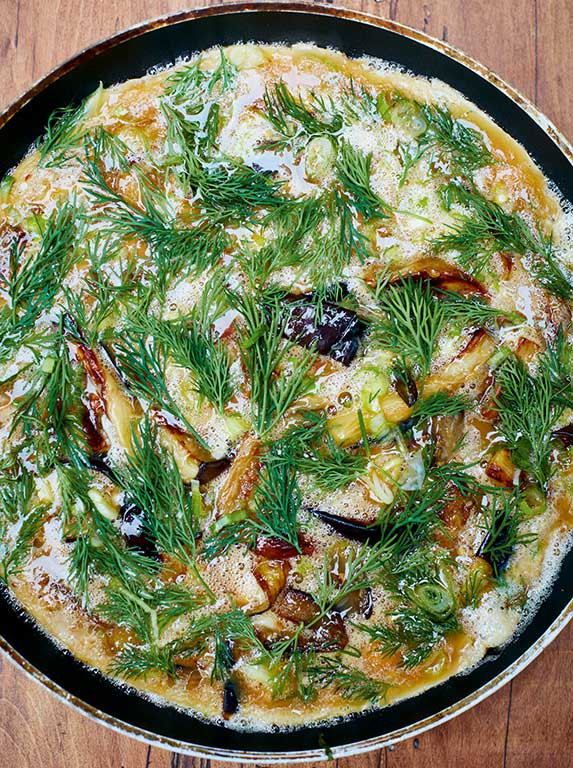Humayun was a Mughal emperor in Delhi in the 1500s. He earned the title “Perfect Man” for his patience and tranquility, and he was partial to refined Persian food, cooked by the best chefs of his day. When he wasn’t eating stuffed roasted whole sheep, or all-white-food feasts, he was fond of this kuku, a gorgeous herby eggplant frittata. In the 1500s they ate this with yogurt and I wouldn’t disagree with that, but a little salad, pickle, and crusty bread are also lovely alongside.
Serves 4 to 6 as a light lunch
2 medium eggplants (about 1¼ pounds)
canola oil
6 scallions, finely sliced
2 cloves of garlic, crushed
1 teaspoon salt
6 medium eggs
½ teaspoon ground black pepper
1 cup fresh dill, leaves picked and chopped
Chop the eggplants into ¼ inch x 2 inch batons.
Pour 1/3 cup of oil into a large frying pan over medium heat and, when hot, add the eggplants. At first they will soak up all the oil, but will eventually start to release it back into the pan. After 10 to 12 minutes, when you can see the oil and the eggplants are lovely and soft, add the scallions, garlic, and ½ teaspoon of salt, and mix together. Take off the heat and leave to cool for 5 minutes.
In the meantime, beat the eggs and season with the remaining ½ teaspoon of salt and the black pepper. When the eggplant mixture has cooled, add it to the eggs and mix.
To cook the kuku, put 2 tablespoons of oil into a non-stick frying pan, around 7½ to 8 inches in diameter, over medium heat. When hot, pour the egg and eggplant mixture into the pan. Reserve a tablespoon of the dill leaves, and sprinkle the rest over the top of the egg mixture. Cook until it starts to leave the sides and the center begins to firm up but isn’t completely set. This should take around 4 minutes, but it’s best to use your own judgment.
Then set a plate over the top of the pan and flip the pan over so that the kuku ends up on the plate. Shuffle or slide it back into the pan to cook the other side for another couple of minutes, or until springy to the touch.
Flip back over, using the same plate technique, so that the lovely dill leaves show on the top of the omelette, and sprinkle over the rest of the dill for good measure.



